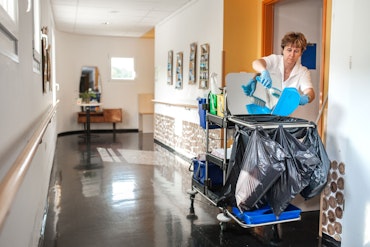One in five aged care workers plan to quit in next 12 months, says ANMF survey
The dire situation of the aged care workforce shortage has been further highlighted by a recent report from the Australian Nursing and Midwifery Federation (ANMF) which found that one in five aged care workers are intending to quit their job within the next 12 months.
![<p>The survey shows that one in five aged care workers are planning to quit their job within the next 12 months, and 37 percent are planning to leave within five years. [Source: Shutterstock]</p>](https://agedcareguide-assets.imgix.net/news/articles/news/articles/8_3_2022-AC-workers-quitting.jpg?fm=pjpg&format=auto&w=550&q=65)
The survey shows that one in five aged care workers are planning to quit their job within the next 12 months, and 37 percent are planning to leave within five years. [Source: Shutterstock]
On top of that, 37 percent of nurses and aged care workers plan to leave their job within one to five years.
The ANMF National Aged Care COVID-19 Survey 2022, released last Thursday, was undertaken over January and February of this year, creating discussions of workplace challenges with nurses and carers in the aged care sector.
ANMF Federal Secretary Annie Butler says that the findings of the survey show how physically and emotionally burnt-out the aged care nurses and care staff are from the long shifts, inadequate breaks and overtime.
“Aged care workers told us they feel ‘unseen, unvalued and cast aside’ – they’re overworked, stressed and are fast losing hope and strength,” explains Ms Butler.
“Overwhelmingly, they told us that understaffing was the major reason for the crisis the system faced during the pandemic.
“Time and time again, [Prime Minister Scott] Morrison and his Ministers were warned of the impending crisis in aged care and despite the devastation of the COVID-19 pandemic, have still done nothing to address the chronic understaffing at the root of so much of the suffering in privately-run nursing homes.
“Most concerning for the ANMF, and indeed the whole community, is the number of aged care staff who reported that they will leave their jobs within the next one to five years – that’s years upon years of experience just walking out the door.
“Lack of effective recruitment and retention of nurses and qualified care workers will only put further strain on a system at breaking point and will lead to more suffering and neglect.”
Other results from the survey show the chronic understaffing issues and problems getting COVID-19 testing kits as well as Personal Protective Equipment (PPE).
One in five aged care workers reported having enough PPE either rarely, sometimes, or not at all. A smaller amount of aged care workers, four percent, relied on paying for their own Rapid Antigen Tests (RATs).
Forty-two percent of aged care workers reported working long periods without sufficient breaks, 40 percent reported working double shifts, and 35 percent worked unpaid overtime hours.
Around 60 percent of aged care workers say that they are working more than they would like.
Additionally, 38 percent of employers were not providing leave with pay if workers were exposed to COVID-19.
The survey found that 72 percent of survey participants have received three doses of the COVID-19 vaccination, with 27 percent only receiving two doses.
This may be an issue for some workers soon, as National Cabinet recently endorsed the booster vaccination being made mandatory for aged care workers.
So far, only New South Wales, South Australia, Victoria, Tasmania, Western Australia and the Northern Territory have implemented the booster mandate.
Ms Butler adds, “The survey shows us that the staff remaining in aged care only do so for the love and respect of the people they care for, but their wages and conditions do not justify the risks and pressure they experience every time they go to work. It’s unsustainable.”
Industry peak bodies Leading Age Services Australia (LASA) and Aged and Community Services Australia (ACSA) believe the ANMF survey reaffirms the dire situation developing in the aged care workforce that the Government needs to address.
Chief Executive Officer (CEO) of LASA, Sean Rooney, says that LASA has been concerned for some time about the ongoing exodus of staff from the aged care sector, as high staff turnover and staff shortages in aged care have been occurring for years and were identified as issues by the Royal Commission into Aged Care Quality and Safety.
However, COVID-19 has exacerbated the problem and put further pressure onto aged care staff – resulting in frustration, fatigue and staff leaving the sector.
“The results of the ANMF survey affirms what we have been hearing and saying for some time,” says Mr Rooney.
“We are already seeing a high turnover of staff in the sector, from nurses to personal care workers through to senior management.
“The pandemic is not yet over and the Commonwealth Chief Medical Officer has warned in the past couple of weeks of the potential for more variants so the pressure on existing staff in the sector will likely continue.”
LASA and ACSA, both part of the Australian Aged Care Collaboration (AACC), have called on the Government to urgently support pay rises for staff and improve training and skills to help attract and retain staff in the sector.
Mr Rooney says, “We know that workers on the frontline are saying they feel fatigued, frustrated, and they feel undervalued and unsupported. As the Royal Commission concluded, aged care workers are consistently undervalued and underpaid.”
The AACC is calling for:
- A Workforce Partnership Supplement for providers to spend immediately on increasing wages, training, minutes of care, 24-hour nursing and COVID-19 prevention and workforce retention costs
- A minimum wage increase for aged care workers by funding the Fair Work Commission Work Value Case and award wage increases from July 2022
- A commitment to a multidisciplinary workforce by putting in place an allied health needs assessment and funding model by July 2024
Mr Rooney says that without these changes to support aged care workers on the frontlines, the ability of aged care services to meet the care needs of older Australians will continue to be compromised.
CEO of ACSA, Paul Sadler says, “These essential workers deserve respect and they deserve better support to encourage successful, long-term careers in the aged care sector.
“Existing, long-term aged care worker shortages have been exacerbated during the COVID pandemic and recent instability.”
ACSA, along with LASA and the AACC, is calling on all political parties to commit to greater action on the aged care workforce ahead of the Federal Election, including initiatives to attract more workers to the sector, pay increases, and fixes to staff and skills shortages.
“The upcoming Federal Budget is also a prime opportunity for the Government to immediately lift staff wages, as recommended by the Aged Care Royal Commission, and publicly commit to fully funding the outcome of the Fair Work Commission aged care work value case process,” says Mr Sadler.
ACSA also supports Government incentives for nursing students to enter aged care roles and more support for care and support workers.
“Taking the longer term perspective, the Federal Government should work with the States and Territories to develop a pathway program for secondary school students into aged care, including more options for people to enter the home care workforce,” adds Mr Sadler.
To view the full survey results, head to the Australian Nursing and Midwifery Federation website.























